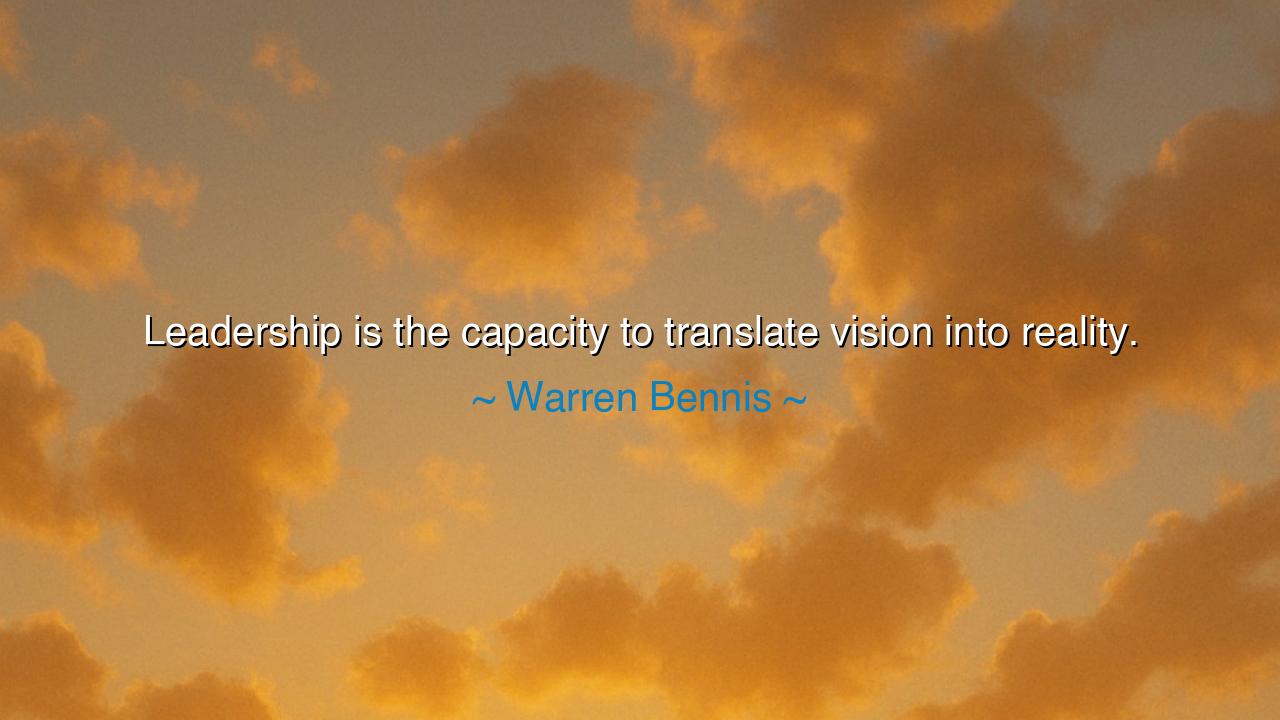
Leadership is the capacity to translate vision into reality.






The words of Warren Bennis, “Leadership is the capacity to translate vision into reality,” resound like a trumpet call across the ages, reminding us that leadership is not mere dreaming, nor empty speech, but the sacred art of transformation. A vision is a fire in the mind, a glimpse of what could be, but until it is made flesh in the world, it is only a phantom. The true leader is the one who bridges that gap, who takes the unseen and makes it seen, who shapes the formless into form. Without vision, leadership is blind; without action, vision is barren. But together, vision and execution give birth to destiny.
The ancients themselves knew this truth. Moses looked upon a promised land, yet it was his leadership that forged wandering tribes into a people and carried them through deserts toward that vision. Alexander the Great dreamed of uniting East and West, and by his sword, his strategy, and his will, he carved empires that stretched farther than any before him. Their visions were mighty, but what made them leaders was their power to translate those visions into the soil of reality. Thus, Bennis gives modern voice to an eternal law: leadership lives in the marriage of dream and deed.
Bennis himself, a scholar of leadership, taught that leaders are not defined by position but by capacity—the inner strength to act. Vision alone belongs to poets and prophets, but the capacity to transform vision into action belongs to leaders. This capacity requires courage to face doubt, discipline to endure obstacles, and wisdom to rally others to the cause. For no vision, however brilliant, can stand unless others are inspired to build it with their own hands.
Consider Abraham Lincoln. He held a vision of a nation united and free, yet his greatness was not in the vision alone—it was in his ability to steer a fractured country through civil war, to hold the Union together when it seemed destined to fall apart. He translated the dream of liberty into the hard reality of emancipation, not through speeches alone but through policy, persistence, and sacrifice. Many had visions of freedom, but Lincoln had the capacity to make that vision real.
The meaning of Bennis’s words is both lofty and practical. Lofty, because they elevate leadership beyond mere authority—it is a divine calling to manifest a greater future. Practical, because they remind us that a leader is judged not by what he imagines, but by what he accomplishes. A leader who speaks of grand visions but fails to act becomes a hollow figure, while one who quietly and faithfully builds, even from small beginnings, proves the essence of true leadership.
The lesson for us is clear: if you would lead, dare to dream boldly, but also prepare to labor diligently. Do not wait for perfection before acting; begin with the light you have, and step forward. Surround yourself with allies who share your vision, and together hammer it into reality. Leadership is not magic, nor is it luck—it is disciplined action guided by an unshakable vision.
The practical action is this: each day, remind yourself of your vision for your life, your family, your work, or your community. Then ask: “What step can I take today to make this vision real?” Small steps, repeated faithfully, build momentum, and momentum carries dreams into reality. Leadership begins not in speeches, but in actions—consistent, visible, and true.
Therefore, O listener, engrave this truth upon your heart: “Leadership is the capacity to translate vision into reality.” Do not be content to dream and admire the horizon from afar. Walk toward it, build upon it, labor for it. For only when the invisible becomes visible, and the dream becomes flesh, can the world say: here was a leader, and here was his legacy.






AAdministratorAdministrator
Welcome, honored guests. Please leave a comment, we will respond soon